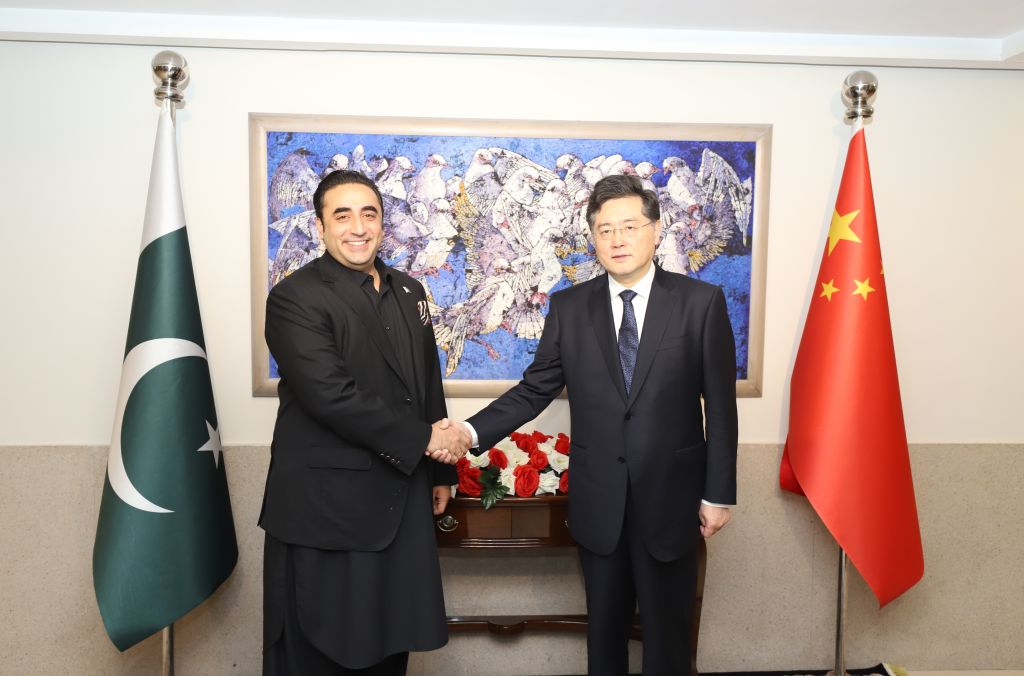More than a year after the Biden administration’s disastrous withdrawal from Afghanistan, it’s now becoming clear who is poised to be the big winner of America’s longest war, besides the Taliban.
It’s China.
Last week Beijing took the decisive steps that will make the Taliban its strategic partner in Xi Jinping’s push for global hegemony, via the vast China-led global infrastructure project known as the Belt and Road Initiative.
China’s impending success, and America’s abject failure, in Afghanistan is both infuriating and enlightening. It should force us to take a hard look at how America conducts itself with friends and enemies alike, especially when it comes to how we use our military force.
China has been looking to become Afghanistan’s economic mentor for more than two years. The breakthrough came May 6, as Chinese Foreign Minister Qin Gang and his Pakistani counterpart, Bilawal Bhutto Zardari, met with the Taliban’s top diplomat, Amir Khan Muttaqi, in Islamabad and agreed to work together on Afghanistan’s reconstruction process by bringing the $60 billion joint China-Pakistan Economic Corridor to Afghanistan.
It’s obvious what the Taliban gets out of this deal: Chinese investments will help to fix a cash-strapped economy after international aid to Afghanistan came to a halt following the American withdrawal.
As for China, turning Afghanistan into its newest client state will allow it to get the first scoop of the country’s vast untapped mineral resources.
According to the Brookings Institution, those reserves are valued between $1 trillion and $3 trillion. A 2019 Afghan mining sector map estimates the Taliban is sitting on 2.3 billion metric tons (MTs) of iron ore, 30 million MTs of copper, and 1.4 million MTs of rare earth materials. The country is also believed to have significant stores of lithium—a crucial element for making of EV batteries and for the transition from fossil fuels—potentially rivaling those of Bolivia, which currently has the world’s largest reserves.
Skeptics of the China push into Afghanistan like the authors at Brookings like to argue that extracting those minerals would be too expensive in a country with almost no transportation infrastructure or industrial economy. But that didn’t prevent China from getting its first contract with the Taliban in January, via a subsidiary of China National Petroleum Corporation, to extract oil from the northern Amu Darya basin. But the skeptics also forgot that China had a clear pathway into Afghanistan, thanks to the other former U.S. ally turned client state in the region: Pakistan.
The China-Pakistan partnership serves as a preview for what’s going to happen in Afghanistan. As relations between Washington and Islamabad deteriorated during the war on terror, Beijing stepped in. In 2015 it set up the $62 billion China-Pakistan Economic Corridor (CPEC), which stretches for more than 1,800 miles, as part of President Xi’s Belt and Road Initiative across Central and South Asia. The sea-and-land based CPEC aimed to reduce China’s dependence on energy imports from the Middle East via the vulnerable sea route through the Straits of Malacca between Malaysia and Indonesia. It includes energy pipelines and a deep-water port at Gwadar in the Arabian Sea, as well as a road and rail line from Gwadar to Xinjiang Province in western China—in other words, building rail lines precisely where it is committing genocide against its Muslim Uyghur minority.
Not that Pakistan’s rulers care, or the Taliban. Despite recent political unrest, Pakistani officials predict that CPEC will create upward of 2.3 million jobs by 2030, and add 2 to 2.5 percentage points to the country’s annual economic growth. Whether they are right is another matter. But the initiative does move Pakistan into the global economy in ways its decades-long alliance with the United States never did.
Now the Taliban is primed for similar Chinese investment, as the CPEC extends itself into Afghanistan. In their May 9 joint statement, the three diplomats reaffirmed “their commitment to further the trilateral cooperation under the Belt and Road Initiative, and to jointly extend the China-Pakistan Economic Corridor to Afghanistan,” including via the port of Gwadar.
It’s interesting to compare China’s plans for investment in both Pakistan and Afghanistan with our investment there, both in blood and treasure. According to the Watson Institute at Brown University, the United States spent $2.313 trillion on the war, including operations in Afghanistan and Pakistan—while 2,402 Americans died in combat and 20,713 were wounded or maimed.
The White House itself tells us that since 2002, the United States gave Afghanistan nearly $88 billion in security assistance, $36 billion in civilian assistance, and nearly $3.9 billion in humanitarian assistance—which has still been underway since the U.S. withdrawal. Yet none of that largesse did anything to establish a secure pro-U.S. government there, or prevent the Taliban from returning to power, or stop China from stepping in to fill the vacuum.
We made the sacrifice; China carries away the rewards. Clearly America needs a new paradigm for how to use its influence and power, including its military power.
Brief, high-intensity so-called punitive expeditions, for example, offer an alternative to the “endless war” syndrome. Thanks to our military’s peerless strategic mobility and high degree of readiness, America can put large numbers of soldiers in a wrongdoer’s country on short notice—and get them out again.
We did this during our initial invasion of Afghanistan in 2001. Overthrowing the Taliban in 2001-02 cost $20.8 billion and a dozen American combat deaths. Then we decided to stay and build democracy. Twenty years and $2 trillion-plus later, we’ve learned a hard lesson in what works and what doesn’t, in projecting military force against our enemies.
Afghanistan offers one other lesson for the future. We can’t allow our current focus on the war in Ukraine and a possible one over Taiwan to distract us from developments in other strategic regions of the world like South Asia and the Middle East. Because where America steps away from its responsibilities, China will step in—and the future of freedom everywhere will look bleaker than ever.






Please note that we at The Dispatch hold ourselves, our work, and our commenters to a higher standard than other places on the internet. We welcome comments that foster genuine debate or discussion—including comments critical of us or our work—but responses that include ad hominem attacks on fellow Dispatch members or are intended to stoke fear and anger may be moderated.
With your membership, you only have the ability to comment on The Morning Dispatch articles. Consider upgrading to join the conversation everywhere.